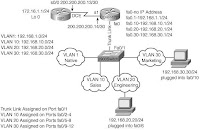VTP Configuration
1900 Series Switch
1900Switch(config)#vtp client ***Changes the switch to VTP client mode
1900Switch(config)#vtp server ***Changes the switch to default VTP server mode
1900Switch(config)#vtp transparent ***Changes the switch to VTP transparent mode
1900Switch(config)#vtp domain CNAP ***Sets the name of the VTP management domain to CNAP
1900Switch(config)#vtp password cisco ***Sets the VTP password to cisco
2900 Series Switch
2900Switch#vlan database ***Enters VLAN database mode
2900Switch(vlan)#vtp client ***Changes the switch to client mode
2900Switch(vlan)#vtp server ***Changes the switch to server mode 2900Switch(vlan)#vtp transparent Changes the switch to transparent mode
2900Switch(vlan)#vtp domain academy ***Sets the name of the VTP management domain to academy
2900Switch(vlan)#vtp password catalyst ***Sets the VTP password to catalyst
2900Switch(vlan)#vtp v2-mode ***Sets VTP mode to version 2
2900Switch(vlan)#vtp pruning ***Enables VTP pruning
2900Switch(vlan)#exit ***Applies the changes and exits mode
2900Switch#
2950 Series Switch
2950Switch#config t ***Enters global config mode
2950Switch(config)#vtp mode client ***Changes the switch to client mode
2950Switch(config)#vtp mode server ***Changes the switch to server mode
2950Switch(config)#vtp mode transparent ***Changes the switch to transparent mode
2950Switch(config)#vtp domain academy ***Sets the name of the VTP management domain to academy
2950Switch(config)#vtp password catalyst ***Sets the VTP password to catalyst
2950Switch(config)#vtp v2-mode ***Sets VTP mode to version 2
2950Switch(config)#vtp pruning ***Enables VTP pruning
Note:
VTP versions 1 and 2 are not interoperable. All switches must use the same version. The biggest difference between version 1 and 2 is that version 2 has support for Token Ring VLANs.
Caution:
Switches that are in client mode update their VLAN database from switches that are in server mode. If you have two or more switches interconnected and you delete a VLAN database, you may find that it becomes updated from a server switch because of your VTP mode.
Another serious problem occurs when you take a new switch in server mode (the default mode) and plug it into an existing network. If the VTP revision number is higher on the new switch, it sends an update to all other switches to overwrite their VLAN database with new informationin this case, an empty VLAN database. You now have a production network with no VLAN information.
Recommended practice is that you put a switch into VTP client mode before adding them into a production network, allow it to receive an update of current VLAN information, and then change it to VTP server mode.
